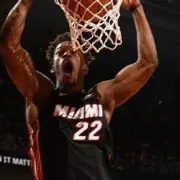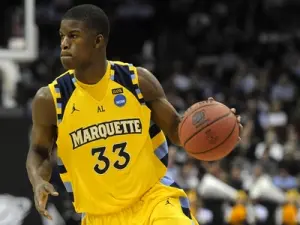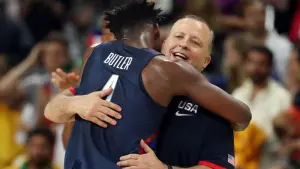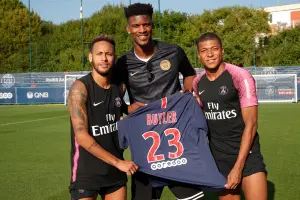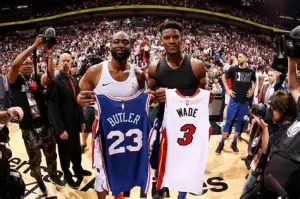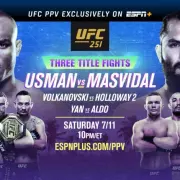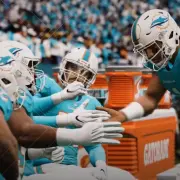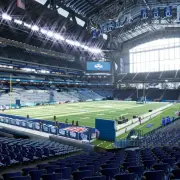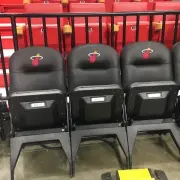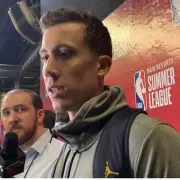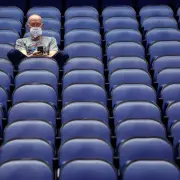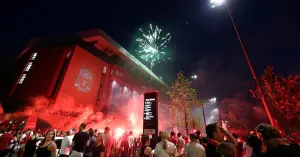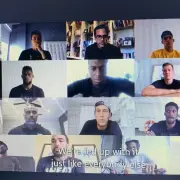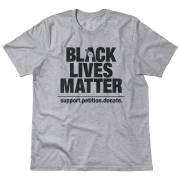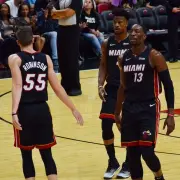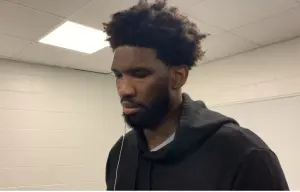Jimmy Butler finally found a home in Miami
Every hero’s journey has his or her own origin story, a path they follow to their ultimate goal. That path is almost always filled with lessons learned, hardships endured, and battles won against villains/doubters that got in their way. The odds are stacked against them, but they persevere even if the odds are 14 million to 1.
The Miami Heat is ready for such a challenge, even if the formidable Milwaukee Bucks, Boston Celtics, Toronto Raptors and Philadelphia 76ers stand in their way. They don’t just believe they can make it to the NBA Finals this fall, they know they can. That determination starts with their leader: Jimmy Butler.
Butler was pushed to his physical limits in Chicago, misunderstood in Minnesota and heartbroken in Philadelphia before arriving in Miami. He has never felt happier or more fulfilled than during this past year with the Heat, but he knows…He knows that he must reach another level to shock the world.
In order to do so, the hero Miami needs will have to reckon with his memories and his own limitations to break through. To understand Butler’s future, the key lies in his past.
DON’T EVER GIVE UP
Still, he loathes reliving the past — so much so that he has removed the rearview mirror on his car (yes, really) as a symbolic reminder to never look back.
Jimmy Butler can be intense. He will get in your face and dare you to play and practice until you pass out, demanding the same amount of selflessness and effort on the court and obsession off of it that he has, challenging preconceptions, and that is not for everyone. It takes a certain culture to embrace that.
We all like to think that we can and will get up from whatever blows life throws at us, but let’s face it. Like Rocky once said, “nobody is gonna hit as hard as life.”
Put yourself in Butler’s shoes: You spend your childhood without a father after dad walks out on you. But you hold no grudges, and you keep going. You grow up in Tomball, Texas, a small town of 10,000+ people close to Houston but far from the spotlight. Its more famous resident for years was former Enron executive Sherron Watkins, but you dream big.
Then you are in middle school, just 13 years old, and you are coming home thinking about that girl you like or that math assignment due the next day. You open the door and your mom Londa tells you “I don’t like the look of you, you gotta go.”
A lot of things must have been going through his head. How can your own mother’s last words to you be so cutting, so searing? At that point, it’s easy to break if you feel all alone. Bur he held no grudges, and he kept going thanks to a support system that propped him up when he felt down.
Butler wasn’t homeless for long. He attended Tomball High School while staying with the Leslies and becoming friends with Jordan, who was two years younger and would eventually make it to the NFL.
Butler would play basketball with Jordan and be Tomball’s MVP after averaging 19 points during his senior year, but there were no state championships or All-American honors on his trophy case. Most disappointingly, there were no recruits or major scholarship offers. His recruiting profile was a faceless ghost, a two-star nobody. But he held no grudges, and he kept going.
FROM ZERO TO HERO
Butler wasn’t ready to give up on his basketball dreams, so he enrolled at a small school 200 miles away called Tyler Junior College. Nobody had ever made it to the NBA out of Tyler before, and nobody has since. He wasn’t even a Top 100 prospect, but the young Texan was relentless and Marquette University’s coach Buzz Williams took notice enough to offer him an athletic scholarship.
Butler arrived at Marquette and contributed as a sixth man to a team that went 25-10 and lost to Missouri in the second round of the NCAA Tournament. Jimmy scored seven points in 30 minutes off the bench, but there was a moment that could have changed everything.
Marquette was up 78-76 with 1:17 to go when Butler took a shot from behind the arc. He was 0-for-3 in three pointers for the season, but he believed in himself. He could make it, he would ice the game and send Marquette to the Sweet 16. However, he missed it, and Missouri came back to win 83-79.
The kid who nobody gave two cents for a year earlier was now a key cog in a contender, and he was ready for more. By the time the 2010-11 campaign came around, Butler was leading the team in minutes with 34.6 per game as he was joined by future Heat teammate Jae Crowder.
Number 33 was cold-blooded, and eager for more. The 2011 NBA Draft awaited him.
THEY WERE SO WRONG
Butler has always had a chip on his shoulder, but more than anything he needed someone to believe in him. Enter Chicago Bulls coach Tom Thibodeau.
The small forward out of Marquette was considered a “jack of all trades, master of none” by many.
In a draft that saw busts like Jan Vesely and Jimmer Fredette as Top 10 selections, destiny would see point guard Norris Cole picked 28th by the Bulls and traded to the Miami Heat. Butler was chosen two spots later, and he was eager to join Derrick Rose and Joakim Noah in Chicago for their quest to dethrone Miami’s own LeBron James, Wade and Bosh from the NBA throne.
Those Bulls would lose in five games to the Heat in the Eastern Conference Finals while Butler played only 42 games and averaged barely 2.6 points in 8.6 minutes per game during the lockout shortened season. Most importantly, Derrick Rose tore his ACL during the first round of those playoffs, and everything changed forever for Butler.
Thibodeau trusted him more after that and gave Butler the chance to play in every single game for the first and only time in his career during the 2012-13 regular season, starting 20 of them. One of those starts was against the Heat, and Butler’s 17 points and four assists in 43 minutes helped snap Miami’s historic 27-game winning streak with a 101-97 win by the home team in Chicago.
As Butler evolved, so did his reputation as a clutch player both defensively and, most importantly for his development, offensively.
The problem was, Thibodeau was running him into the ground. Butler averaged career-highs in both 2014 and 2015 with 38.7 minutes per game on his way to being named the NBA’s Most Improved Player and an Eastern Conference All-Star for the first time before signing a five-year, $95 million extension with the Bulls.
2016 saw him get the nod and recognition he craved, getting the nod from Coach K to go to Rio and win the gold medal with Team USA, averaging 5.6 points and 14 minutes a game while playing in every single one of them. His best outing came in the Group Stage against Venezuela, contributing 17 points and a +26 plus/minus in a 113-69 rout.
Butler also fell in love with soccer while in Brazil, where fuchibol is a religion, and forged a friendship with Brazilian superstar Neymar a year later when both of them were in Paris for fashion week.
Back in America, Butler was thriving as Chicago’s go-to scorer in the playoffs, where he averaged over 22 points in 2015 and 2017 along with a blistering 42.9 minutes on the court. However, the Bulls were regressing as Butler was progressing, so the Bulls traded Jimmy to Minnesota on June 22, 2017 for young players such as Zach LaVine and Lauri Markkanen.
The Bulls were rebuilding, but Butler had visions of a championship with the Timberwolves alongside Karl-Anthony Towns and Andrew Wiggins. In theory, those three should have at least put a scare into the Golden State Warriors, but Butler never meshed with them and requested a trade barely over a season after arriving.
THE LONG ROAD TO MIAMI
The “feud” between Butler and Towns was all sorts of ugly, and the press was having a field day concocting theories about Towns’ girlfriend cheating on him with Butler. There was a trend, and that trend was the perception of Butler as a destabilizer.
Minnesota was losing and looking like the NBA version of “Melrose Place”, but in reality all the personal stuff was secondary to what Butler saw as a lack of toughness and will to overcome in Towns and Wiggins.
It all erupted during a practice session that saw Butler play for the backups and decimate the Timberwolves’ starters, calling Towns “soft”. There was no coming back from calling out the franchise’s #1 draft pick, so the team took sides and chose Towns while trading Butler to the Philadelphia 76ers.
Butler was rubbing people the wrong way as a basketball nomad, a troublemaker and disruptor. He even was being labeled as a dreaded “locker room cancer” by the national talking heads.
In reality, Butler didn’t really want to go to Philly. He already had his sights set in South Florida even if the insiders thought otherwise.
Minnesota's Jimmy Butler has three preferred destinations for a trade, league sources tell ESPN: The Brooklyn Nets, Los Angeles Clippers and New York Knicks. Those three teams have max cap space to sign Butler as a free agent in July.
— Adrian Wojnarowski (@wojespn) September 19, 2018
Once in Philadelphia, he took that team to another level and found a kindred spirit in Joel Embiid. In fact, he played just as well as Kawhi Leonard during the Sixers-Raptors series that Toronto won in seven games thanks to Kawhi’s miracle shot.
In fact, he could have been the Game 7 hero after tying the game with a layup in the final seconds, but it was just another heartbreak for Jimmy.
Bur he held no grudges, and he kept going, reiterating his desire to play in Miami once again after that season was over. The problem was that Miami had no cap space, or so everybody thought.
Pat Riley pulled off his magic in a sign-and-trade that shipped a malcontent Hassan Whiteside to Portland and guard Josh Richardson to Philadelphia.
So now he is ready to finish what he started and being homeless no more. Butler found his basketball home in Miami, and his family with the Heat. His philosophy has rubbed off on his teammates, there is no softness in the red and white.
I will never quit. I persevere and thrive on adversity. My team expects me to be physically harder and mentally stronger than my opponents. I will draw on every remaining ounce of strength to protect my teammates and to accomplish our mission. I am never out of the fight. pic.twitter.com/iUD7iFln8R
— Meyers Leonard (@MeyersLeonard) July 23, 2020
With allies like that, Butler believes nothing is impossible. Not after garnering his third career All-Star nod and leading the Heat to a 41-24 record this year. More than anything, he finally feels right at home.
